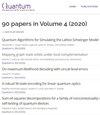Meson dynamics from locally exciting a particle-conserving $Z_2$ lattice gauge theory
IF 5.1
2区 物理与天体物理
Q1 PHYSICS, MULTIDISCIPLINARY
引用次数: 0
Abstract
Quantum simulation of lattice gauge theories is an important avenue to gain insights into both particle physics phenomena and constrained quantum many-body dynamics. There is a growing interest in probing analogs of high energy collision phenomena in lattice gauge theories that can be implemented on current quantum simulators. Motivated by this, we characterize the confined mesons that originate from a local high energy excitation in a particle-conserving 1D $Z_2$ lattice gauge theory. We focus on a simple, experimentally accessible setting that does not require preparation of colliding wavepackets and isolates the effects of gauge field confinement strength and initial state energy on the nature of propagating excitations. We find that the dynamics is characterized by the propagation of a superposition of differently sized mesons. The linear confinement leads to meson size oscillations in time. The average meson size and oscillation frequency are controlled by the strength of the gauge field confinement. At a constant confinement field, the average meson length is controlled by the initial excitation's energy. Higher energies produce longer mesons and their effective mass depends strongly on their size: longer mesons propagate more slowly out of the central excitation. Mesons of different sizes get spatially filtered with time due to different speeds. We show that this phenomenology is a consequence of linear confinement and remains valid in both the strong and weak confinement limit. We present simple explanations of these phenomena supported by exact numerics.局部激发守恒粒子Z_2晶格规范理论的介子动力学
晶格规范理论的量子模拟是深入了解粒子物理现象和受限量子多体动力学的重要途径。人们对探测晶格规范理论中高能碰撞现象的类似物越来越感兴趣,这些类似物可以在当前的量子模拟器上实现。在此基础上,我们描述了一维$Z_2$晶格规范理论中源自局部高能激发的受限介子。我们专注于一个简单的,实验上可实现的设置,不需要准备碰撞波包,并且隔离了规范场约束强度和初始状态能量对传播激发性质的影响。我们发现动力学的特征是不同大小介子的叠加传播。线性约束导致介子尺寸在时间上的振荡。平均介子尺寸和振荡频率由规场约束强度控制。在恒定约束场中,平均介子长度由初始激发能量控制。更高的能量产生更长的介子,它们的有效质量在很大程度上取决于它们的大小:更长的介子从中心激发中传播得更慢。不同大小的介子由于速度的不同而随时间发生空间过滤。我们证明了这种现象学是线性约束的结果,并且在强约束和弱约束极限下都是有效的。我们用精确的数字对这些现象作了简单的解释。
本文章由计算机程序翻译,如有差异,请以英文原文为准。
求助全文
约1分钟内获得全文
求助全文
来源期刊

Quantum
Physics and Astronomy-Physics and Astronomy (miscellaneous)
CiteScore
9.20
自引率
10.90%
发文量
241
审稿时长
16 weeks
期刊介绍:
Quantum is an open-access peer-reviewed journal for quantum science and related fields. Quantum is non-profit and community-run: an effort by researchers and for researchers to make science more open and publishing more transparent and efficient.
 求助内容:
求助内容: 应助结果提醒方式:
应助结果提醒方式:


